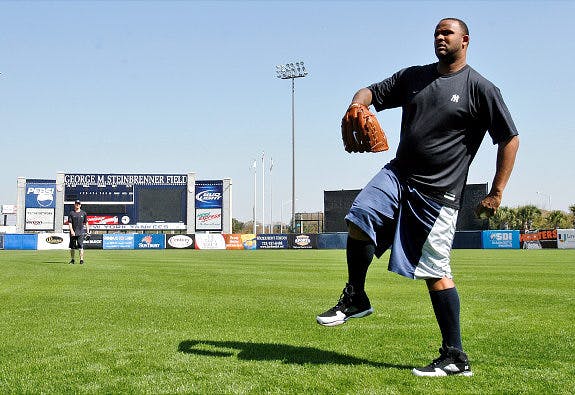Featured courses
- Understanding The Shift by Brandon Ogle
- Two Drills to Improve Outfield Movement and Communication by Grant Young
- The Ultimate Resource For Coaching Youth Baseball by Jackson Chlebowy
- Become a Master at Bunting by Brandon Ogle
- 5 Reasons Why There Is More To Good Base Running Than Just Speed by Brandon Ogle
- Three Injury-Prevention Tips For Your Offseason Pitching Program by Grant Young
- How to Teach Hitting to the Next Generation by Grant Young
- Developing Defensive-Minded Baseball Catchers by Grant Young
- 3 Baserunning Tips to Score More Runs in Baseball by Grant Young
- 5 Outfield Drills to Work on in Season by Alec Burris
- Keys For Scoring More With Runners on First and Third Base by Grant Young
- How to Develop Your Game to Become a Five-Tool Player by Brandon Ogle
- 3 Coaches Share the Keys to Running Baseball Practice the Right Way by Grant Young
- Four Drills to Sharpen a Baseball Hitter’s Vision at the Plate by Grant Young
- Four Quotes to Hit Better With Two-Strikes by Grant Young
- Four of Former MLB Pitcher Juan Nieves’ Movement-Based Pitching Drills by Grant Young
- Two Tips For Developing an Elite Baseball Bullpen by Grant Young
- Overcoming the Four Challenges of Indoor Baseball Practices Because of Weather by Grant Young
- Three Tips to Make Your Baseball Team Mentally Tougher by Grant Young
- Three Priceless Philosophies to Motivate Your Baseball Team by Grant Young
- Three Offseason Baseball Drills to Simulate Competition by Grant Young
- Three Baseball Offseason Strength and Conditioning Essentials by Grant Young
- Important Ways to Improve Your Baseball Team’s Baserunning by Grant Young
- Three Ways to Perfect Hitting Mechanics From an MLB Icon by Grant Young
- Catchers can influence pitchers...for bad or good by Drew Johnson
- Throwing Strikes and Playing Good Defense Equals Wins by Jose Ortiz
- Legendary Indiana Head Baseball Coach Bob Morgan’s Offensive Theory by Grant Young
- Tennessee Head Baseball Coach Tony Vitello on How to Practice Baserunning by Grant Young
- Three Great T-Ball Drills For Youth Baseball Players by Grant Young
- How to Manage a Baseball Pitching Staff by Grant Young
- Three Uncommon Tips to Become a Better Hitter by Grant Young
- How a Baseball Coach Can Develop Strike Throwers by Grant Young
- Drills to Develop Elite Baseball Outfielders by Grant Young
- Baseball Training Exercises to Strengthen Arm and Bat Speed by Grant Young
- How to Use Bunting to Score More Runs by Grant Young
- How To Build An Elite Baseball Infielder by Grant Young
- Three Drills to Improve Your Baseball Team's Infield Play by Grant Young
- Three Keys to Curating a Pitching Staff’s Success by Grant Young
- 3 Techniques to Develop a Baseball Player’s Hitting Approach by Grant Young
- How to Cultivate Confidence Within Your Pitchers by Grant Young
- 5 Every Day Drills To Help You Become A Better Catcher by tyler Linderman
- How to Throw A Curveball by Brandon Ogle
- How to Assemble a Lock-Down Bullpen by Brandon Ogle
- How to Throw a Sinker by Brandon Ogle
- How to be a Smart Baserunner by Brandon Ogle
- Improving a player's slugging average by Phillip Woolgar
- The 8 Fundamentals of Pitching by Drew Johnson
- How to Throw a Deceiving Changeup by Brandon Ogle
- Step Up Your Outfield Defense With These Three Drills by Jose Ortiz
- 8 Baseball Drills Every Player Should Practice by Drew Johnson
- How To Become An Elite Defensive Outfielder by Tyler Linderman
- 5 Tips For Crushing A Curveball by Johnny Grassi
- LEGENDS FOR YOUTH INCLUSION BASEBALL CLINIC by Phil
- Fourteen Ways To Turn A .300 Hitter Into A .210 Hitter by Jay P. Granat, Ph.D.
- How To Become The Ideal Leadoff Man by Brandon Ogle

Three Injury-Prevention Tips For Your Offseason Pitching Program
- By Grant Young
Having a baseball offseason pitching program is crucial for injury prevention. After a long season of pitching, the arm and shoulder muscles need time to rest and recover. Baseball pitching tips for an offseason program should focus on allowing pitchers to employ strengthening and conditioning exercises that can help prevent overuse injuries. By incorporating exercises to improve flexibility, strength, and overall arm health, pitchers can reduce the risk of injury and prepare their bodies for the next season.
However, this doesn’t mean that a pitcher can’t improve during the offseason. It just means they should be throwing with less volume than they would during the year. In fact, proper mechanics and technique can be emphasized during the offseason, which can contribute to injury prevention during the regular season.
Every pitcher and pitching coach should know the basics of a proper offseason program:
A structured strength and conditioning program should be implemented to build overall strength, endurance, and power while also addressing any muscular imbalances.
Arm care exercises, such as tubing and resistance band work, are essential for maintaining arm health and preventing injuries.
A gradual return to throwing program should be followed to gradually build up arm strength and throwing volume in preparation for the upcoming season.
But players and coaches need the specifics of exactly what workouts, drills, and pitching volume to utilize in order to set themselves up for (healthy) success during the season. This is why Chans Chapman’s ‘Reagan Pitching, September to June’ course should be a must for everyone within the pitching community.
Chapman is the head baseball coach of Reagan High School. Since coming to Reagan in 2004 as the Head Baseball Coach, Coach Chapman’s teams have won 9 District Championships, 11 Regional Finals trips, and State tournament appearances in 2014, 2017, and 2018. The 2008 team was ranked as high as #5 in the nation by Baseball America.
Coach Chapman’s aforementioned course takes us through his goals and routine to ensure that his pitchers will become better in the offseason, all while keeping their arms as healthy as can be.
Goals
What’s important to understand about high school and college pitchers is that when their regular (spring) season ends with their school team, they typically go straight into summer baseball. And since these innings thrown in the summer are just as intense as in the spring, this is essentially an extension of the season.
Therefore, Coach Chapman asserts that the true recovery period comes in the Fall, when the pitchers come back to school.
Depending on what level you’re at, Coach Chapman suggests that it’s advisable to give pitchers at least one month completely off of throwing at some point after their summer baseball ends. Ideally (especially for high school athletes who may be playing other sports) you want to aim for about two months without them picking up a baseball.
While this may seem counterproductive to development as a pitcher, the arm requires rest if it’s to function and stay healthy in the ways we want it during the season.
Another hot topic that Coach Chapman addresses is building up to throwing off the mound in a season. While every coach understands that ramping a player up too fast is dangerous for their arm health, some prefer to wait longer than others. A common strategy at the collegiate level is to get players throwing out to 180-200 feet before they even think about pitching at full intensity.
Before they step on a mound, pitchers should have thrown at least 3-5 flat-ground bullpens to get a feel for their pitches and ease back into their rhythm and mechanics.
Lifting Program

As any baseball coach knows, having a regimented strength and conditioning program is integral for ensuring a pitching staff’s sustained success in a season.
Coach Chapman has his pitchers lift five times per week in the offseason. While that may sound like a lot, not every day is at a high intensity, and the team dials it back to two to three times per week during the season in order to maintain the strength they gained during the offseason.
While Coach Chapman’s staff does a good amount of heavier lifts like hand cleans and front squats, they’re also meticulous about including body weight and lighter weight exercises that are pitcher-specific and not just about building “weight room strength”.
Exercises like medicine ball throws, cable raises, pushups, reverse flys, and anything that targets the lower back, abs, and core are extremely important for pitchers because the core is where balance comes from and balance is crucial when it comes to being a pitcher.
Also worth noting is that, while pitchers may want to compete with one another in the weight room to see who can lift the heaviest, this is dangerous and can lead to injuries. Every pitcher has a different strength capacity, and the only person they should be competing with in the weight room is themselves.
Pitching Drills
A great offseason (and really at any point in the season) drill to do is what’s called a towel drill. It involves pitchers partnering up with one of them holding a 10-inch towel in their throwing hand. That pitcher will then go through their pitching motion. Wherever their front foot lands, they’ll take three steps and that’s where their partner will place their glove.
The pitcher will then go through their motion at full intensity and try to whack their partner’s glove as hard as they can. Because this drill doesn’t involve throwing a ball, it’s much healthier on the arm. And giving the pitcher a target to hit will force them to stride far and follow through, which builds and reinforces great habits.



